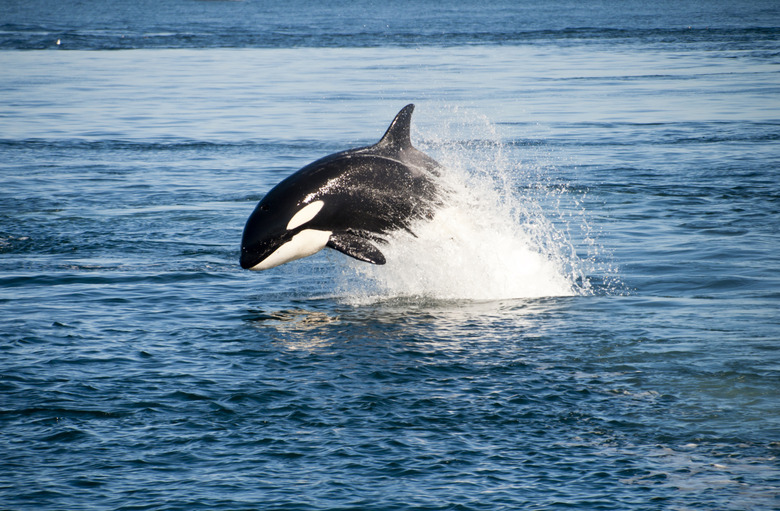How Do Whales Protect Themselves?
Whales are some of the largest animals in the sea – in fact, the blue whale is the biggest animal on the planet! However, the blue whales' massive size doesn't exclude them from being hunted by blue whale predators. One of the biggest whale predators is actually other whales – namely killer whales, or orcas.
Though popular as a tourist attraction for whale-watching ships, killer whales live up to their name and are just as deadly as great white sharks. Unlike great whites, orcas use their intelligence to work together as a group, which gives them the upper hand for hunting prey as massive as a whale.
Fight or Flight
Fight or Flight
Like almost every other animal, whales have a "fight or flight" response to being attacked. When being hunted by killer whales in arctic waters, belugas will use sea ice to evade their fellow cetaceans and provide barriers to help them escape. In coastal regions, such as Cook Inlet in Alaska, the smaller belugas can also flee to shallow waters where the killer whales cannot easily pursue them.
Gray whales, on the other hand, have been known to fight back against whale predators when fleeing just won't cut it. Though an adult gray whale might be able to flee from a pod of orcas, their young calves cannot, so the mother often takes the offensive. In fact, the gray whale earned the nickname "devilfish" during whaling times because it had a reputation for ramming vessels that attacked the whale itself or its calves.
Banding Together
Banding Together
Both anecdotal evidence and scientific research have indicated that whales also band together when they feel threatened.
In 1997, a group of scientists from the National Oceanic and Atmospheric Administration witnessed a group of nine sperm whales being attacked by a pod of killer whales. The scientists said the sperm whales attempted to beat back these sperm whale predators by arranging in a circular formation, with their heads pointed inward, and using their tail fins to swipe at the orcas. They were ultimately unsuccessful.
A 2013 study in the journal Scientific Reports by a team of European scientists found male sperm whales become increasingly social and vocal upon hearing killer whale songs. Interception of the killer whale songs have allowed the sperm whales to change their behavior and avoid potential predation.
Blubber Layers
Blubber Layers
A whale's thick layer of blubber also affords some additional protection from predators. Attacks on the whale result in more superficial injuries to the blubber, rather than reaching vital organs. In addition to being a protective layer against would-be predators, blubber affords all whales protection against hypothermia.
Heat loss in water is 27 times greater than on land, and blubber helps to keep a whale's body heat inside the animal. This fatty layer comprises 27 percent of the massive blue whale's total body weight.
Blubber is actually comprised of three layers: the dermis, epidermis and hypodermal tissue. While the dermis and epidermis of a blue whale are similar to what is found in other mammals, the hypodermal tissue is mostly made up of fat cells and is similar to the layer of fat found underneath the skin of a pig.
The Bizarre Defense Mechanism of Pygmy Sperm Whales
The Bizarre Defense Mechanism of Pygmy Sperm Whales
Any discussion about the defense mechanisms of whales is not complete without mentioning the pygmy sperm whale. Only about twice the size of the average human when fully mature, pygmy sperm whales tend to live their entire lives offshore at depths of between 1,300 and 3,000 feet.
When these modestly sized whales are under attack, they defend themselves by releasing fecal material into the water and swirling it around with their fins. The whales are undoubtedly banking on the notion that swimming through a cloud of feces will put off any predator's appetite.
References
- World Wildlife Fund: Beluga
- National Oceanic and Atmospheric Administration Fisheries: Gray Whale
- Scientific Reports: Responses of Male Sperm Whales (Physeter Macrocephalus) to Killer Whale Sounds: Implications for Anti-Predator Strategies
- University of Wisconsin, LaCrosse: Blue Whale Adaptation
- University of Nebraska – Lincoln: Killer Whale Predation on Belugas in Cook Inlet, Alaska: Implications for a Depleted Population
Cite This Article
MLA
Smith, Brett. "How Do Whales Protect Themselves?" sciencing.com, https://www.sciencing.com/whales-protect-themselves-4566498/. 30 September 2021.
APA
Smith, Brett. (2021, September 30). How Do Whales Protect Themselves?. sciencing.com. Retrieved from https://www.sciencing.com/whales-protect-themselves-4566498/
Chicago
Smith, Brett. How Do Whales Protect Themselves? last modified March 24, 2022. https://www.sciencing.com/whales-protect-themselves-4566498/
